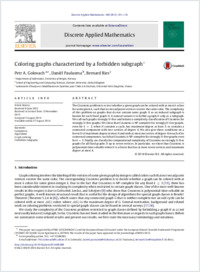Coloring graphs characterized by a forbidden subgraph
BP2-STS
- Golovach, Petr A. University of Bergen, Norway
- Paulusma, Daniël Durham University, United Kingdom
- Ries, Bernard ORCID Université Paris Dauphine-PSL
- 2014
Published in:
- Discrete Applied Mathematics. - Elsevier BV. - 2014, vol. 180, p. 101-110
Applied Mathematics
Discrete Mathematics and Combinatorics
Complexity
Algorithms
Graph coloring
Forbidden subgraph
English
The Coloring problem is to test whether a given graph can be colored with at most k colors for some given k, such that no two adjacent vertices receive the same color. The complexity of this problem on graphs that do not contain some graph H as an induced subgraph is known for each fixed graph H. A natural variant is to forbid a graph H only as a subgraph. We call such graphs strongly H-free and initiate a complexity classification of Coloring for strongly H-free graphs. We show that Coloring is NP-complete for strongly H-free graphs, even for k = 3, when H contains a cycle, has maximum degree at least 5, or contains a connected component with two vertices of degree 4. We also give three conditions on a forest H of maximum degree at most 4 and with at most one vertex of degree 4 in each of its connected components, such that Coloring is NP-complete for strongly H-free graphs even for k = 3. Finally, we classify the computational complexity of Coloring on strongly H-free graphs for all fixed graphs H up to seven vertices. In particular, we show that Coloring is polynomial-time solvable when H is a forest that has at most seven vertices and maximum degree at most 4.
- Faculty
- Faculté des sciences économiques et sociales et du management
- Department
- Département d'informatique
- Language
-
- English
- Classification
- Computer science and technology
- License
- Rights reserved
- Open access status
- bronze
- Identifiers
-
- DOI 10.1016/j.dam.2014.08.008
- ISSN 0166-218X
- Persistent URL
- https://folia.unifr.ch/unifr/documents/322636
Statistics
Document views: 53
File downloads:
- coloring.pdf: 121
